Kia Niro: Service Highlight / High voltage battery handling guide
| High voltage battery system
inspection guide |
|
Be sure to read and follow the “General Safety Information and
Caution” before doing any work related with the high voltage system.
Failure to follow the safety instructions may result in serious
electrical injuries.
|
| 1. |
Carry out a visual inspection to determine whether the vehicle
requires general repair or accident repair.
|
| 2. |
For the general repair, perform the repair based on the repair
process for that DTC code.
|
| 3. |
For the car accident repair, determine the accident type before
repair.
|
1) Electrical Accidents
| – |
Over-charge/discharge: Displays a battery over voltage (P1B71)
code /low voltage (P1B70) code (Refer to the DTC diagnosis guide).
|
| – |
Short: Displays a high voltage short (P1B77, P1B25) codes (Refer
to the DTC diagnosis guide).
|
2) Fire
|
Classification
|
Inspection process
|
Inspection results
|
Measures
|
Fire outside of the high voltage battery mount
※Example)
Engine fire
|
| 1. |
Perform visual inspections (deformation, corrosion, wire coating,
odor, connector).
|
| 2. |
Check for main fuse open circuit after shutting off the high
voltage.
|
| 3. |
Check the high voltage main relay for signs of welding.
|
| 4. |
Measure the high voltage battery/chassis insulation resistance.
|
| 5. |
Check other parts for failure.
|
| 6. |
Check the DTC code in the BMS ECU.
|
|
High voltage battery insulation damaged
|
Remove the high voltage battery and repair the insulation process/coating.
|
High voltage battery not damaged
|
DTC code
|
If a DTC code occurs, comply with DTC diagnosis guide and repair process.
|
No DTC code and battery appears normal
|
Do not replace the high voltage battery (if the battery is damaged and must
be disposed of, perform the high voltage battery disposal process).
|
Fire in the high voltage battery mount
※Example)
Trunk fire
|
| 7. |
Perform visual inspections (deformation, corrosion, wire coating,
odor, connector).
|
| 8. |
Check for visible damage of the high voltage battery.
|
| 9. |
Check the high voltage main relay for signs of welding after
shutting off the high voltage if no visible damage is found in the
high voltage battery.
|
| 10. |
Measure the high voltage battery/chassis insulation resistance.
|
| 11. |
Check other parts for failure.
|
| 12. |
Check the DTC code in the BMS ECU.
|
|
High voltage battery appears damaged (heat, soot, etc.)
|
Remove the service disconnect plug and perform the salt water battery disposal
process.
|
High voltage battery insulation damaged
|
Remove the high voltage battery and repair the coating/insulation.
|
High voltage battery not damaged
|
DTC code
|
If a DTC code occurs, perform the repair process outlined in the DTC diagnosis
guide.
|
No DTC code and battery appears normal
|
Do not replace the high voltage battery (if the battery is damaged and must
be disposed of, perform the high voltage battery disposal process).
|
3) Collision
Classification
|
Inspection process
|
Inspection results
|
Measures
|
Collision damage to areas other than the high voltage battery mount
※Example)
Front/side collision
|
| 13. |
Perform visual inspections (deformation, corrosion, wire coating,
odor, connector).
|
| 14. |
Check for main fuse open circuit after shutting off the high
voltage.
|
| 15. |
Check the high voltage main relay for signs of melting.
|
| 16. |
Measure the high voltage battery/chassis insulation resistance.
|
| 17. |
Check other components.
|
| 18. |
Check the DTC code in the BMS ECU.
|
|
High voltage battery insulation damaged
|
Remove the high voltage battery and repair the coating/insulation.
|
High voltage battery not damaged
|
DTC code
|
If a DTC code occurs, perform the repair process outlined in the DTC diagnosis
guide.
|
No DTC code and battery appears normal
|
Do not replace the high voltage battery (if the battery is damaged and must
be disposed of, perform the high voltage battery disposal process).
|
Collisions involving the high voltage battery mount
※Example)
Rear-end collision
|
| 19. |
Perform visual inspections (deformation, corrosion, wire coating,
odor, connector).
|
| 20. |
Check for main fuse open circuit after shutting off the high
voltage.
|
| 21. |
Check the high voltage main relay for signs of melting.
|
| 22. |
Measure the high voltage battery/chassis insulation resistance.
|
| 23. |
Check other components.
|
| 24. |
Check the DTC code in the BMS ECU.
|
|
High voltage battery insulation damaged
|
⇑ Follow the measures outlined above.
※ If the high voltage battery mount is inaccessible due to trunk or door
damage, bend or cut the exterior panels without damaging the high voltage
system and carry out the inspection and repair process.
|
High voltage battery not damaged
|
DTC code
|
No DTC code and battery appears normal
|
4) Submersion
Classification
|
Inspection process
|
Inspection results
|
Measures
|
High voltage battery not submerged
|
| 25. |
Perform a visual inspection (deformation, corrosion, wire coating,
odor, connector).
|
| 26. |
Check for main fuse open circuit after shutting off the high
voltage.
|
| 27. |
Check the high voltage main relay for signs of melting.
|
| 28. |
Measure the high voltage battery/chassis insulation resistance.
|
| 29. |
Check other components.
|
| 30. |
Check the DTC code in the BMS ECU.
|
|
High voltage battery insulation damaged
|
Remove the high voltage battery and repair the coating/insulation.
|
High voltage battery not damaged
|
DTC code
|
If a DTC code occurs, perform the repair process outlined in the DTC diagnosis
guide.
|
No DTC code and battery appears normal
|
Do not replace the high voltage battery (if the battery is damaged and must
be disposed of, perform the high voltage battery disposal process).
|
High voltage battery submerged
[Regardless of water conditions]
|
| 31. |
Check for main fuse open circuit after shutting off the high
voltage.
|
| 32. |
Check the high voltage main relay for signs of melting.
|
| 33. |
Measure the high voltage battery/chassis insulation resistance.
|
| 34. |
Check the DTC code in the BMS ECU.
|
|
Carry out these measures regardless of the inspection results
|
Remove the high voltage battery and repair the coating/insulation.
|
| 1. |
Remove the safety plug lever (A).
|
| 2. |
Remove the safety plug cover (A) and then remove the main fuse (B) by
removing the mounting bolts.
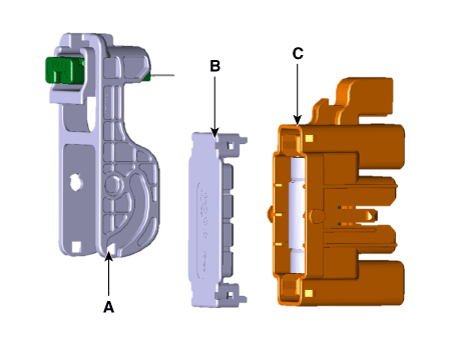
|
| 3. |
Measure the resistance of main fuse.
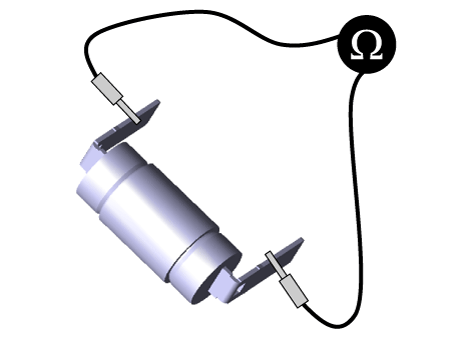
|
Specification: 1 Ω or less [20°C(68°F]
|
|
| 4. |
If the measured resistance is not within the specification, replace the
main fuse.
|
| Checking for Welding in the High Voltage
Main Relay |
In order to safely remove the battery pack assembly, you must first inspect the
high voltage main relay for signs of weld damage.
You can use Gloval Diagnostic System (KDS/GDS) service data to detect weld damage
in the high voltage main relay.
[Using KDS/GDS service data to check for main relay weld damage]
| 1. |
Connect the KDS/GDS to the self-diagnosis connector (DLC).
|
| 3. |
Check the BMS weld damage state in the KDS/GDS service data.
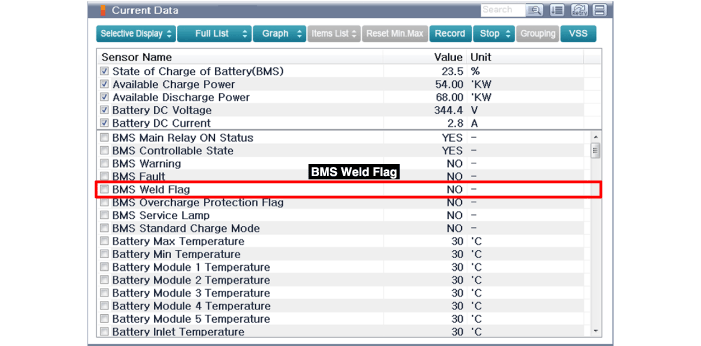
|
[Using a Multimeter to measure weld damage]
| • |
Be sure to read and follow the “General Safety Information and
Caution” before doing any work related with the high voltage system.
Failure to follow the safety instructions may result in serious
electrical injuries.
|
| • |
Be sure to shut off the high voltage before doing any work related
with the high voltage system(Refer to "High Voltage Shut-off Procedure").
Failure to follow the safety instructions may result in serious
electrical injuries.
|
|
| 1. |
Shut off the High Voltage circuit.
(Refer to Hybrid Control System - “High Voltage Shutoff Procedure”)
|
| 2. |
Remove the rear seat cushion.
(Refer to Body - "Rear Seat Assembly")
|
| 3. |
Remove the rear door scuff trim.
(Refer to Body - "Door Scuff Trim")
|
| 4. |
Remove the inlet cooling duct.
(Refer to High Voltage Battery Cooling System - "Cooling Duct")
|
| 5. |
Remove the high voltage battery rear cover.
(Refer to High Voltage Battery System - "Case")
|
| 6. |
Disconnect the high voltage (-) connector (A) and high voltage (+) connector
(B).
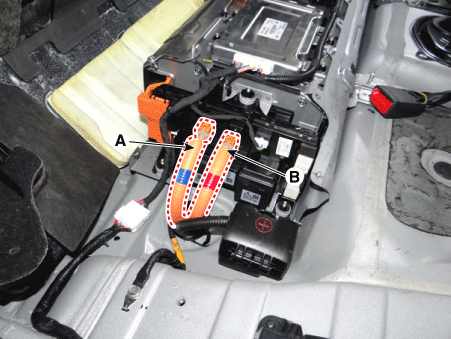
|
| 7. |
Measure the high voltage main relay resistance and check for signs of
weld damage.
|
Specification: 1 Ω or less [20°C (68°F)]
|
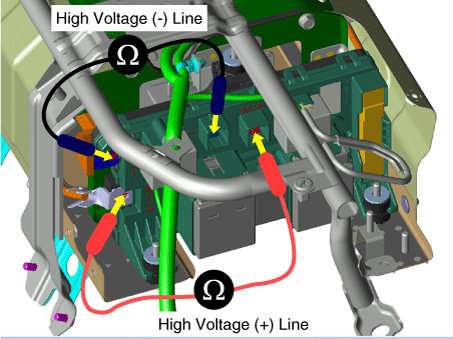
|
| Isolation Resistance Inpection |
The high voltage isolation used in hybrid systems can be checked using KDS/GDS
service data or by measuring it directly.
[Using KDS/GDS service data to check isolation resistance]
| 1. |
Connect the KDS/GDS to the self-diagnosis connector (DLC).
|
| 3. |
Check the isolation resistance in the KDS/GDS service data.
|
Normal insulation resistance range: Around 1.0 MΩ
|
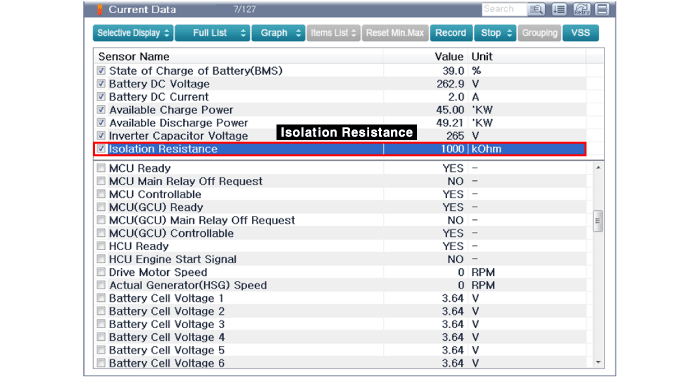
|
[Measuring isolation resistance using an insulation tester (MΩ tester)]
| • |
Be sure to read and follow the “General Safety Information and
Caution” before doing any work related with the high voltage system.
Failure to follow the safety instructions may result in serious
electrical injuries.
|
| • |
Be sure to read and follow the “High Voltage Shut-off Procedures”
before doing any work related with the high voltage system. Failure
to follow the safety instructions may result in serious electrical
injuries.
|
|
| 1. |
Shut off the high voltage circuit.
(Refer to Hybrid Control System - "High Voltage Shut-off Procedures")
|
| 2. |
Remove the rear seat cushion.
(Refer to Body - "Rear Seat Assembly")
|
| 3. |
Remove the rear door scuff trim.
(Refer to Body - "Door Scuff Trim")
|
| 4. |
Remove the inlet cooling duct.
(Refer to High Voltage Battery Cooling System - "Cooling Duct")
|
| 5. |
Remove the high voltage battery rear cover.
(Refer to High Voltage Battery System - "Case")
|
| 6. |
Connect the insulation tester (-) terminal (A) to the battery system
case (or ground).
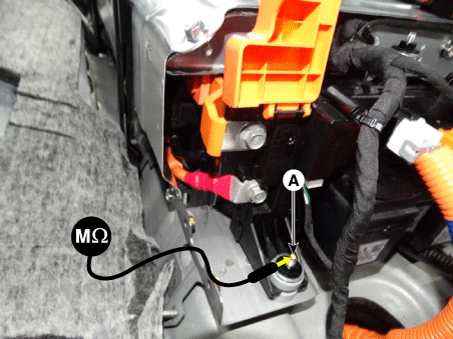
|
| 7. |
Connect the insulation tester (+) terminal to the high voltage battery
(+) and (-). Measure the resistance.
[Measure the isolation resistance on the power relay assembly high voltage
power terminal (+)]
| (1) |
Connect the insulation tester (+) terminal to the (+) PRA high
voltage power terminal (A).
|
| (2) |
Supply 500V through the insulation tester and wait one minute
to measure the stable resistance.
|
| (3) |
Check the isolation resistance.
|
Normal insulation resistance range : Above 1.0 MΩ
|
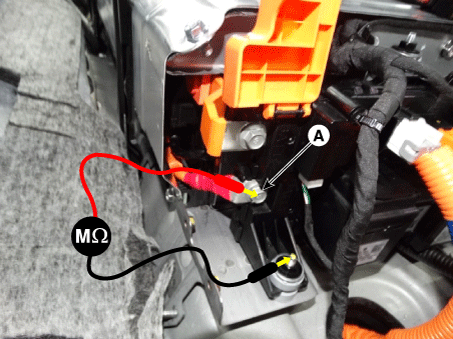
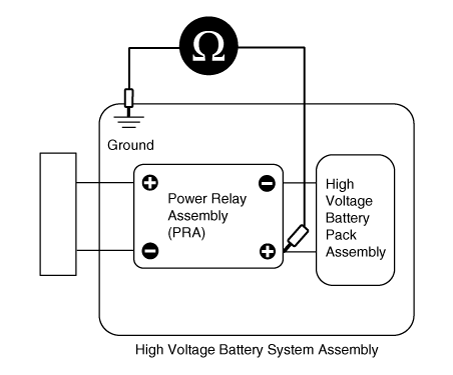
|
[Measure the isolation resistance on the power relay assembly high voltage
power terminal (-)]
| (1) |
Connect the insulation tester (+) terminal to the (-) PRA high
voltage power terminal (B).
|
| (2) |
Supply 500V through the insulation tester and wait one minute
to measure the stable resistance.
|
| (3) |
Check the isolation resistance.
|
Normal insulation resistance range: Above 1.0 MΩ
|
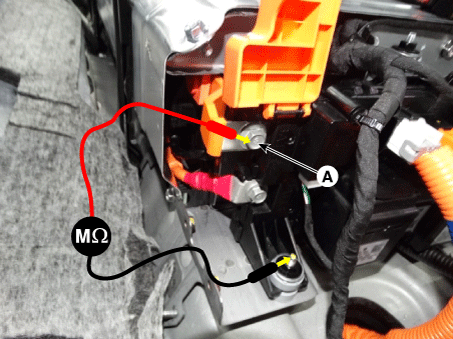
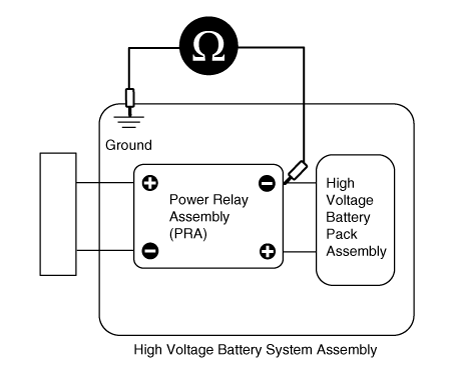
|
[Measure the isolation resistance on the power relay assembly inverter
power terminal (+)]
|
When measuring the insulated resistance on each PRA inverter,
use a contact pin to prevent damage on the connector and for more
accurate measurement.
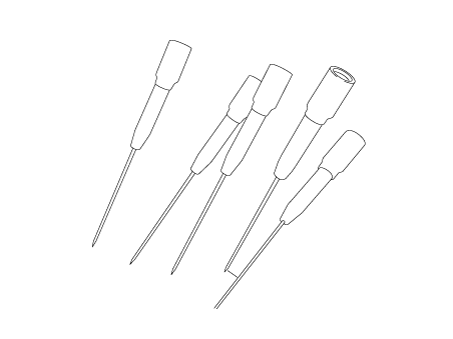
|
| (1) |
Connect the insulation tester (+) terminal to the (+) PRA inverter
power terminal (A).
|
| (2) |
Supply 500V through the insulation tester and wait one minute
to measure the stable resistance.
|
| (3) |
Check the isolation resistance.
|
Normal insulation resistance range: Above 1.0 MΩ
|
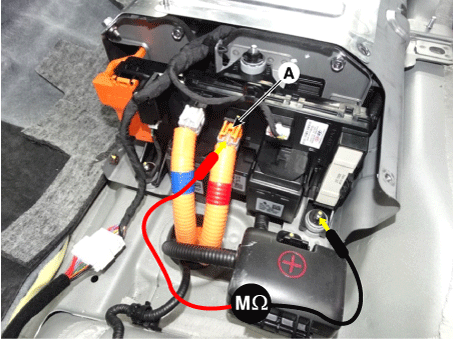
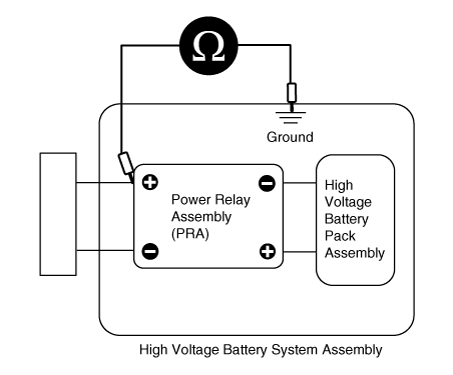
|
[Measure the isolation resistance on the power relay assembly inverter
power terminal (-)]
|
When measuring the insulated resistance on each PRA inverter,
use a contact pin to prevent damage on the connector and for more
accurate measurement.

|
| (1) |
Connect the insulation tester (+) terminal to the (-) PRA inverter
power terminal (B).
|
| (2) |
Supply 500V through the insulation tester and wait one minute
to measure the stable resistance.
|
| (3) |
Check the isolation resistance.
|
Normal insulation resistance range: Above 1.0 MΩ
|
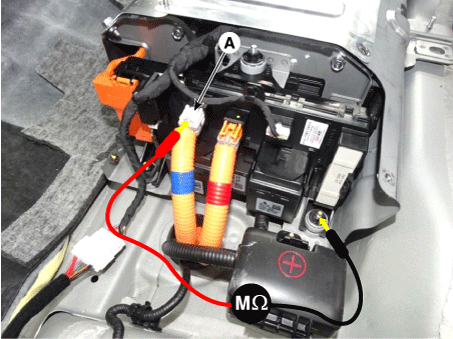
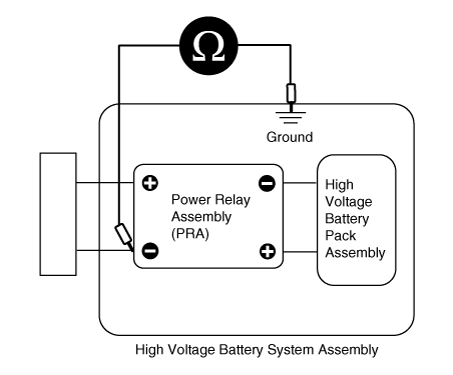
|
|
| Handling Guide for Storing,
Transporting, and Disposing of High Voltage Battery Systems |
| 1. High voltage battery system handling
process |
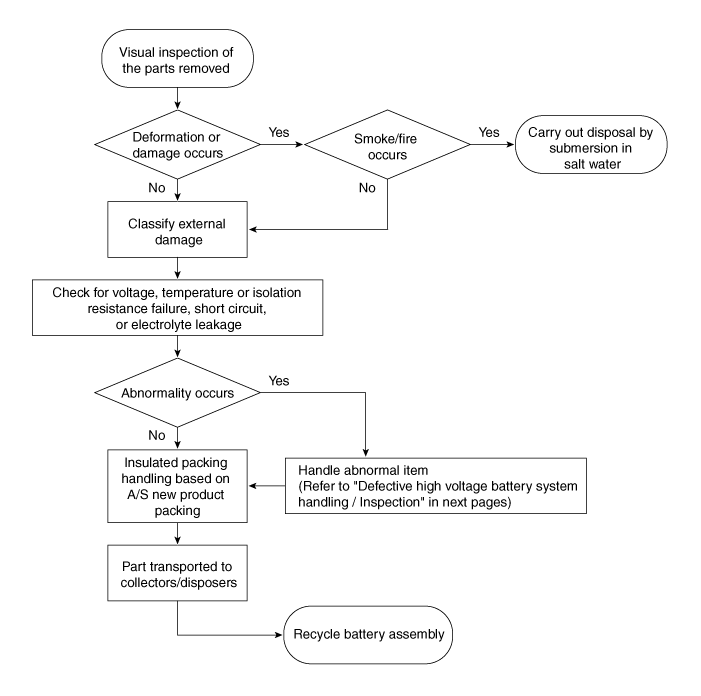
| 2. Defective high voltage battery system
handling / Inspection |
Classification
|
Item
|
Measures
|
Undamaged Battery
|
Storage
|
Remove the service disconnect and store the battery under the same conditions
as a new battery.
|
Transport
|
Minimize impacts and ensure the battery does not come in contact with other
parts.
|
Disposal
|
Transport the battery to the designated disposer
|
Damaged battery
|
Common
|
Inspection method
|
| 4. |
Voltage check (using a digital multimeter)
| (1)
|
Measure the voltage between the service disconnect plug
upper (+) terminal and [High voltage battery – PRA] connecting
cable (-) terminal.
→ Specification: About 120 V
|
| (2)
|
Measure the voltage between the service disconnect plug
lower (-) terminal and [High voltage battery – PRA] connecting
cable (+) terminal.
→ Specification: About 120 V
|
▶ Measures: If abnormal, submerse the battery in salt water immediately
to prevent fire.
|
| 5. |
Temperature check (using a non-contact thermometer)
| (1)
|
Check the temperature of battery case.
|
| (2)
|
Check for temperature changes by measuring the temperature
again after 30 minutes.
|
▶ Criteria: The change should be 3 °C(37.4 °F) or less and the
temperature should be below 35 °C.
▶ Measures
| –
|
If the temperature is higher than 35°C(95 °F) , place
the battery in a cool, dry place and wait for the battery
temperature to return to 35°C(95 °F).
|
| –
|
If the temperature change is more than 3°C(37.4 °F) and
it continues to rise, submerse the battery in salt water
immediately.
|
| –
|
If the temperature continues to rise when measuring it
at 30 minute intervals, submerse the battery in salt water
immediately.
|
|
| 6. |
Isolation resistance check (using a MΩ tester)
| (1)
|
Measure the isolation resistance between the power relay
terminal (+) and the battery pack cover.
|
| (2)
|
Measure the isolation resistance between the power relay
terminal (-) and the battery pack cover.
|
▶ Criteria: 5MΩ or less (at 500V)
▶ Measures: Insulate the battery using insulating materials.
(Refer to "Take insulation actions for parts that may short circuit.)
|
| 7. |
Take insulation actions for parts that may short circuit (Visual
inspection)
| (1)
|
High voltage battery – PRA cable terminal
|
| (2)
|
BMS voltage sensing connector
|
▶ Insulation actions
| –
|
Use the insulation tape or rubber cap to prevent short
circuit to the battery pack, cells, modules.
|
| –
|
Fix the connector terminal to prevent wiring from moving.
|
|
| 8. |
Electrolyte leakage check
| –
|
Check for odors within 30cm (11.8 inch, 0.98 ft) of the
battery pack (electrolyte odors like chemicals or acryl).
|
▶ Measures: Submerse the battery in salt water immediately if
a smell is detected.
|
|
Damaged battery
|
Damaged battery check results: normal
|
Storage
|
Remove the service disconnect plug and store the battery under the same
conditions as a new battery.
|
Transport
|
Minimize impacts and ensure the battery does not come in contact with other
parts.
|
Disposal
|
Transport the battery to the designated disposer; discharge it by submersing
it completely in salt water and carry out the disposal procedure.
|
Damaged battery check results: abnormal
|
Storage
|
Remove the service disconnect plug; insulate all exposed terminals; place
the battery in a cool, dry place away from volatile or combustible substances;
use insulating materials (insulation tape, rubber caps, etc.) or vinyl to
wrap the battery; use anti-shock materials inside the box.
▶ Insulation action: Refer to "Take insulation actions for parts that may
short circuit.
▶ Packing: Abnormal battery must be packed as same as a new battery.
|
Transport
|
Minimize impacts and ensure the battery does not come in contact with other
parts.
|
Disposal
|
Transport the battery to the designated disposer; discharge it by submersing
it completely in salt water and carry out the disposal procedure.
|
Voltage Check
| • |
Be sure to read and follow the “General Safety Information and
Caution” before doing any work related with the high voltage system.
Failure to follow the safety instructions may result in serious
electrical injuries.
|
| • |
Be sure to read and follow the “High Voltage Shut-off Procedures”
before doing any work related with the high voltage system. Failure
to follow the safety instructions may result in serious electrical
injuries.
|
|
| 1. |
Measure the voltage between the service disconnect plug upper (+) terminal
and [High voltage battery –PRA] connecting cable (-) terminal.
→ Specification: About 120 V
|
| 2. |
Measure the voltage between the service disconnect plug lower (-) terminal
and [High voltage battery –PRA] connecting cable (+) terminal.
→ Specification: About 120 V
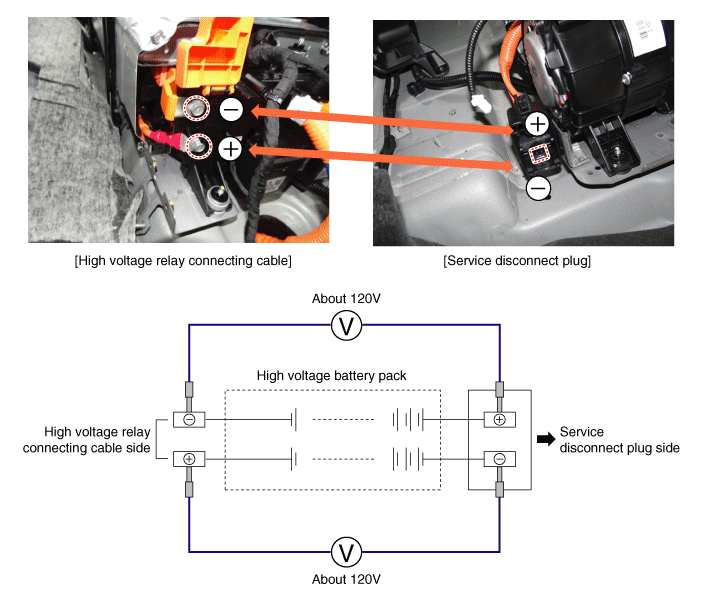
|
Take insulation actions
for parts that may short circuit
| 1. |
High voltage battery – PRA cable terminal

| – |
Place the insulation tape or rubber cap around the (+), (-) cable
terminal to prevent short circuit to the battery pack.
|
| – |
Secure the cable to the battery pack case with the insulation
tape to prevent cables from moving.
|
|
| 2. |
BMS voltage sensing connector
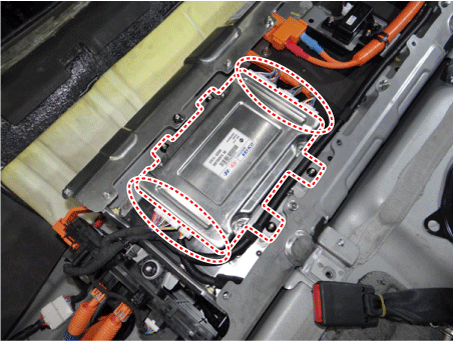
▶ Insulation actions
| – |
Place the insulation tape or rubber cap around connectors to
prevent short circuit to the battery cells, modules.
|
| – |
Secure the wiring to the battery pack case with the insulation
tape to prevent wiring from moving.
|
|
| Discharging high voltage batteries
|
|
Be sure to read and follow the “General Safety Information and
Caution” before doing any work related with the high voltage system.
Failure to follow the safety instructions may result in serious
electrical injuries.
|
|
High voltage batteries can cause electric shocks or other injuries. If the
following symptoms are detected in a high voltage battery, discharge it
as soon as possible by submersing it in salt water.
| – |
There are traces of fire or smoke.
|
| – |
The voltage of the battery is abnormally high (302 V or higher).
|
| – |
The temperature of the high voltage battery continues to rises
abnormally.
|
| – |
It smells like chemicals or acryl, which suggests electrolyte
leakage.
|
[Discharging a battery by submersing it in salt water]
| 1. |
Pour about 53 gallons (200 liters) water into a plastic container
(Ex. Poly Propylene) that cans submerge the whole battery.
|
| 2. |
Add 238 pounds of salt to the water. Stir the water until the
salt dissolves into the solution.
|
[The amount of salt] = 0.538 * [The amount of water that
a battery can be fully immersed]
|
|
| 3. |
Use a lift jack to submerge the high voltage battery in the salt
water.
|
| 4. |
Leave the battery in the salt water for 12 hours before taking
it out a drying it thoroughly.
|
The battery should be dried in a ventilated shade to
avoid direct sunlight, snow and rain.
|
|
|
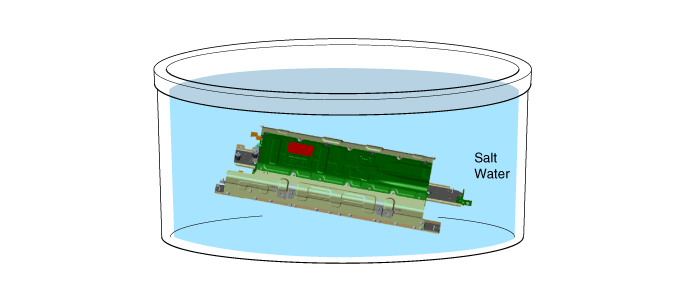
|
Put only one high voltage battery in a single salt water tank.
If you discharge more than one battery, put in the battery after discharging
the previous battery completely to ensure safety.
If not, unexpected accidents such as burns may occur by exothermic reaction.
|
High Voltage Shut-off Procedures
•
Be sure to read and follow the “General Safety Informat ...
Procedure for entering engine
forced activation mode
If the engine needs to be running constantly while the vehicle is stopped to
inspect emission gas or perform maintenance on the ...


 High voltage shut-off procedures
High voltage shut-off procedures Inspection mode procedures
Inspection mode procedures





















